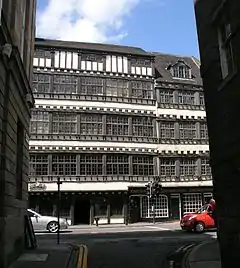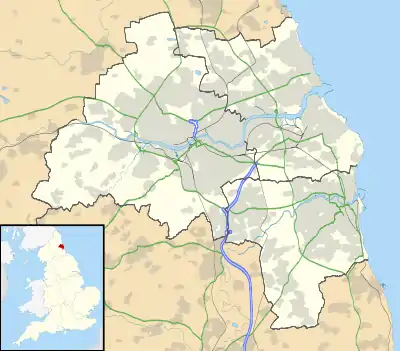Bessie Surtees House
Bessie Surtees House is the name of two merchants' houses on Newcastle's Sandhill, near to the river, that were built in the 16th and 17th centuries.[1] The buildings are a fine and rare example of Jacobean domestic architecture. An exhibition detailing the history of the buildings can be found on the first floor. The site is also home to the North East regional branch of English Heritage and Historic England. It is a Grade I listed building.[2]
| Bessie Surtees House | |
|---|---|
 | |
 Bessie Surtees House (Sandhill) | |
 Location in Tyne and Wear | |
| General information | |
| Location | Tyne and Wear, England, UK |
| Coordinates | 54.967°N 1.612°W |
| OS grid | NZ249637 |
The house is best known as the scene of the elopement of Bessie Surtees and John Scott, who later became Lord Chancellor.[3] It was restored in 1930 by SR Vereker, later Lord Gort, who employed an engineer to install 17th-century fixtures taken from properties about to be demolished. Newcastle City Council purchased the house in 1978. They leased it to English Heritage in 1989.[4]
In July 2009 it was targeted by graffiti vandals who extensively spray-painted the roof with the tags "LG", "GRIM" and "KAME".[5]
References
- Bessie Surtees House (1 January 2017). "Bessie Surtees House - Historic House / Palace in Newcastle upon Tyne, Newcastle upon Tyne". NewcastleGateshead. Retrieved 8 July 2017.
- Profile at British Listed Buildings retrieved 6 January 2013
- Lonely Planet. "Bessie Surtees House in Newcastle-upon-Tyne, England". Lonely Planet. Retrieved 8 July 2017.
- "- English Heritage". english-heritage.org.uk. Retrieved 4 April 2015.
- "BBC NEWS - UK - England - Tyne - Graffiti vandals target landmark". bbc.co.uk. Retrieved 4 April 2015.
External links
| Wikimedia Commons has media related to Bessie Surtees House. |
- Bessie Surtees House – English Heritage